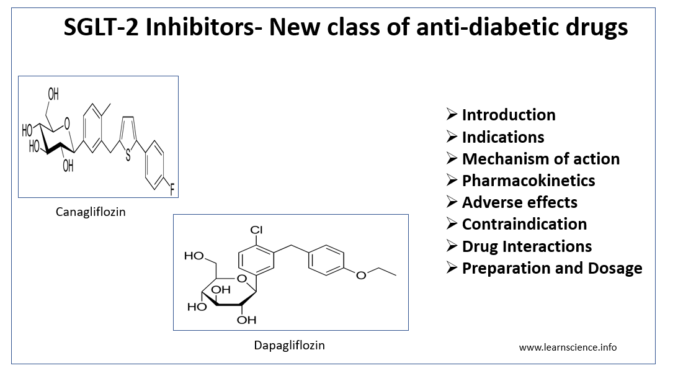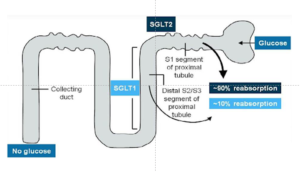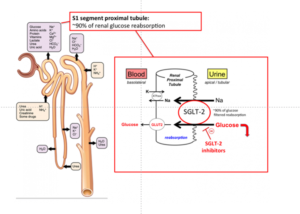
What are SGLT-2 inhibitors?
- SGLT-2 Inhibitors or sodium- glucose co-transporter 2 inhibitors are class of medications used to lower high blood glucose level in type 2 diabetes. They are also known as gliflozins.
- Canagliflozin was first SGLT-2 inhibitor to get approved by FDA, recently in 2013. FDA had approved 4 SGLT-2 inhibitors till now. They are:
- Canagliflozin
- Dapagliflozin
- Empagliflozin
- Ertugliflozin
Indication of SGLT-2 inhibitors
- Used to treat type 2 diabetes. They are mostly used as 2nd or 3rd line agent and used in combination with other agents like metformin.
- Physicians may describe it for type 2 diabetes in following conditions;
- In patients who have problems in taking insulin shots.
- If patient is taking several anti-diabetic medicines and still blood glucose level is not lowered.
- Patient cannot tolerate other anti-diabetics.
- If diabetics patient needs to lose body weight or lower blood pressure.
Mechanism of action of SGLT-2 inhibitors

Figure- Reabsorption of glucose by SGLT-2

Figure- Mechanism of action of SGLT-2 inhibitors
- Kidneys are responsible for renal gluconeogenesis and reabsorption of glucose from glomerular filtrate. Sodium- glucose transporter 2 protein located in renal tubules of kidney reabsorb glucose back into the blood. It is responsible for 90% of glucose reabsorption in proximal tubule.
- SGLT-2 inhibitors inhibit SGLT-2 protein and inhibit renal absorption of glucose and increased excretion of glucose in urine. The result is lowering of blood glucose level.
- Besides glucose level decrease, they are also providing other benefits like reduction in body weight, HbA1C level. They also help in blood pressure and serum uric acid reduction.
Pharmacokinetics
- They are mostly available as oral pills.
| Name of drug | Bioavailability | Protein binding | Half-life (hours) |
| Canagliflozin | 65% | 99% | 10-14 |
| Dapagliflozin | 78% | 91% | 12 |
| Empagliflozin | 90-97% | 86.20% | 13 |
| Ertugliflozin | 70-90% | 95% | 11-17 |
Table 1- Pharmacokinetic parameters of different SGLT-2 inhibitors
Adverse effects
- As more glucose is excreted in urine, the chances of genitourinary tract infection increase. They are more common in female than in male.
- They can cause hyperkalemia, hyperphosphatemia and hypermagnesemia. Risk of hyperkalemia is higher if used in combination with other drugs that affect potassium excretion.
- Osmotic diuresis (frequent pee), increased serum creatinine, hypoglycemia and dehydration may occur. Diabetic ketoacidosis can occur rarely.
- Their use in pregnancy and breastfeeding have not been evaluated.
Contraindications
- They should not be used in
- Type 1 diabetes
- In patient with diabetic ketoacidosis or in patient with severe kidney problems and
- In person on dialysis
- Contraindicated in patients allergic to it.
Drug Interaction
- Canagliflozin can increase AUC (Area under Curve) and peak concentration of digoxin. It is UGT enzyme substrate so its level can be reduced by strong UGT inducers like phenytoin, phenobarbital and rifampin.
- Canagliflozin increases blood level and effects of digoxin.
- Combining SGLT-2 inhibitors with diuretics may increase diuresis and increase risk of dehydration. When used in combination with insulin or drugs that increase insulin secretion, may increase risk of hypoglycemia.
Preparation and Dosage
Canagliflozin– 100 and 300 mg tablets. The starting dose is 100 mg once daily before meal and can be increased up to 300 mg/day. In patients with renal impairment, the maximum dose used is 100 mg.
Dapagliflozin– 10 mg tablet and the dose is one tablet per day. It is also available as combination tablet (dapagliflozin 5 mg + 850/1000 mg metformin) with dose 1 tablet bid.
Empagliflozin– 10 and 25 mg tablets.
References
- Lam CSP, Chandramouli C, Ahooja V, Verma S. SGLT‐2 Inhibitors in Heart Failure: Current Management, Unmet Needs, and Therapeutic Prospects. Journal of the American Heart Association. 2019; 8(20).
- Singh M, Kumar A. Risks Associated with SGLT2 Inhibitors: An Overview. Curr Drug Saf. 2018; 13(2): 84-91.
- https://www.uspharmacist.com/article/sglt2-inhibitors-a-review-of-canagliflozin
- Pharmacology and Pharmacotherapeutics. 24th edition.